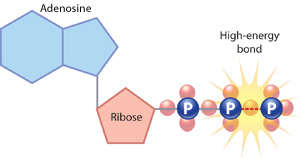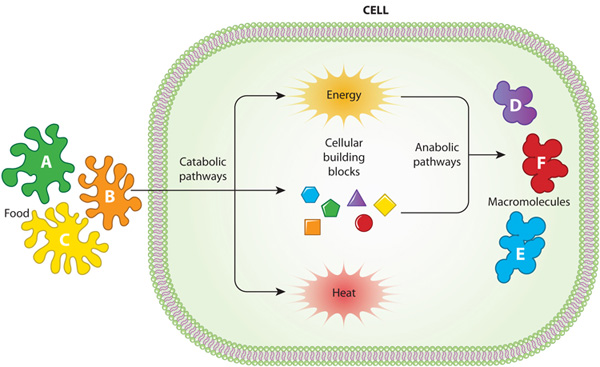Building Larger Molecules Within Cells Can Best Be Described as
Cells perform the functions of life through various chemical reactions. B Fats and carbohydrates are oxidized directly to produce cellular energy.

6 Levels Of Structural Organization At Level
Building larger molecules from smaller ones c citric acid cycle.

. In this example NaCl is the solute and water is the. There are two types of metabolic reactions. Catabolic pathways are those that generate energy by breaking down larger molecules.
Aerobic pathway d glycolysis. 2003-35 In the cell membrane model shown above the molecules which move large molecules into and out of the cell are known as a. Build large molecules from small molecules.
A relatively large molecule consisting of a chain or network of many identical or similar monomers chemically bonded to each other. Anabolic pathways are those that require energy to synthesize larger molecules. DNA is the largest macromolecule found in living cells.
In an _____ reaction a molecule loses one or more electrons. As described in Chapter 2 enzymes are remarkable molecules that determine all the chemical transformations that make and break covalent bonds in cells. Compartments within cells e.
When small organic molecules are joined together they can form giant molecules or polymers. Cytokines are signaling proteins that trigger cellular responses Cytokines are proteins that initiate DNA replication Cytokines are proteins that are used to build large molecules Cytokines are enzymes that catabolize nutrients How do interferons fight viral infections. Energy The four different categories of large organic molecules found within cells are ______.
Using glucose to build noncarbohydrate structures b anabolism. Catabolism breaking down molecules Anabolic and catabolic pathways. These processes require energy in the form of a molecule called ATP.
A Gluconeogenesis is the opposite of that statement. A The amino acid pool is the bodys total supply of amino acids in the bodys proteins. They bind to one or more ligands called substrates and convert them into one or more chemically modified products doing this over and over again with amazing rapidity.
A macromolecule is best described as a molecule composed of repeating units of smaller building blocks True or false. Some reactions require energy. Catabolic pathways are those that generate energy by breaking down larger molecules.
Base your answer on the diagram below which represents stages in the digestion of a starch and on your knowledge of biologyThe products would most likely contain. Noncarbohydrate sources are used to build glucose. These giant molecules are also called macromolecules.
Nuclei and centrioles 18. A group of cells that serve a common function. Both types of pathways are required for maintaining the cells energy balance.
The diagram below represents levels of organization 10. In cells small organic molecules serve as building blocks for the synthesis of larger molecules and provide the _____ required to drive cellular processes. The coated vesicle is derived from the plasma membrane of the cell through a dynamic process called receptor-mediated endocytosis whereby large molecules are brought into the cell.
BASKETLIKE NETWORK of protein molecules called clathrin coats a closed spherical piece of membrane called a vesicle which was isolated from a human placenta. A relatively small molecule that can form covalent bonds with other molecules of this type to form a polymer. Both types of pathways are required for maintaining the cells energy balance.
Food consists of organic carbon-containing molecules that store energy in the chemical bonds between their atoms. Metabolism describes all the chemical reactions that occur within living organisms to maintain life. Anabolic pathways are those that require energy to synthesize larger molecules.
C Amino acids can be used to supply energy only after being converted to a carbohydrate intermediate. Metabolism -- The sum of all chemical reaction within a cell. These two molecules are -.
Organisms use the atoms of food molecules to build larger organic molecules including proteins DNA and fats lipids and use the energy in food to power life processes. Which of the following best describes the chemical reaction called. Biological polymers are large molecules composed of many similar smaller molecules linked together in a chain-like fashion.
Chromosomes can be described as A large molecules that have only one function B folded chains of bonded glucose molecules C reproductive cells composed of molecular bases D coiled strands of genetic material 9. Food Molecules Are Broken Down in Three Stages to Produce ATP. The large molecules necessary for life that are built from smaller organic molecules are called biological macromolecules.
The individual smaller molecules are called monomers. In anabolic reactions small molecules are built up into larger molecules. Ribosomes and cell membranes d.
Linking of two or more molecules by the removal of one or more water molecules. An enzyme is best described as _____. The differences between two molecules include the type of sugar that forms a section of the molecules and the identify of one of the four nitrogenous bases that make up another section of the molecules.
Proteins are large complex molecules that play many critical roles in the body. There are four major classes of biological macromolecules carbohydrates lipids proteins and nucleic acids and each is an important component of the cell and performs a wide array of functions. Proteins are made up of hundreds or thousands of smaller units called amino acids which are attached to one another in long chains.
Saltwater is a solution of NaCl dissolved in water. The proteins lipids and polysaccharides that make up most of the food we eat must be broken down into smaller molecules before our cells can use themeither as a source of energy or as building blocks for other molecules. It can also be described as catabolism anabolism.
The association of lipid molecules within cell membranes. Question 33 13 Which of the following best describes cytokines. Within a cell of a multicellular organism.
The pores or cells that Hooke described were really a. By breaking the bonds in food molecules cells release energy to build new. 2002-15 These words were written by Robert Hooke in 1665.
D Excess carbohydrate and fat can be stored as such whereas excess amino. They do most of the work in cells and are required for the structure function and regulation of the bodys tissues and organs.

Infographic Anatomy Of A Cell Kids Discover Teaching Biology Anatomy Science Cells

Cell Energy Cell Functions Learn Science At Scitable

Cell Energy Cell Functions Learn Science At Scitable

Biology 101 Cells Prokaryotic Cell Cell Diagram Prokaryotes
Levels Of Organization From Simplest To Most Complex At Level

Graphique D Education De Biologie Pour Le Diagramme De Cellules Vegetales Banque D Images 80713899 Plant Cell Plant Cell Model Cell Model

What Are Aha Bha Pha What Are The Differences Major B Holistic Skin Care Beautiful Skin Care Skin Facts

Cell Organelles And Its Functions Psc Online Book Biology Worksheet Cell Organelles Science Cells

Cell Definition Types Functions Diagram Division Theory Facts Britannica Biology Systems Biology Cell Definition

Building Blocks Of Life Chart Uses Colorful Graphics To Show The Steps From Us Down To Atoms And Molecules This Help What Is Atom Atom Activities Helping Kids

The Science Of Asea Asea Science Health Technology

Stemthusiast Biology Notes In 2022 Biology Notes Biology Covalent Bonding

Eukaryotic Cell Structure Eukaryotic Cell Cell Biology Cell Parts

Ashistudy On Instagram Study Notes School Organization Notes School Study Tips

Prokaryotic Vs Eukaryotic Cells Worksheets Eukaryotic Cell Cells Worksheet Prokaryotic Cell

Photosynthesis With M M S After Learning The Photosynthetic Equations Students Put Their Knowledge To Work Photosynthesis Science Education Biology Classroom



Comments
Post a Comment